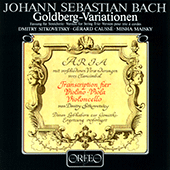Gérard Caussé
Having studied first at Toulouse, Caussé completed his training at the Paris Conservatoire, winning first prizes in viola and chamber music. As well as giving solo recitals and appearing as a soloist with orchestras worldwide he has played chamber music with numerous quartets and ensembles throughout his career. He is currently Professor of Viola at the Paris Conservatoire and the Queen Sofia College of Madrid.
Caussé regards Mozart as the first composer to realise the viola’s potential as the ‘mediator’ between upper and lower stringed instruments, both orchestrally and in the string quartet. He is also a champion of new repertoire for the viola: a number of concertos have been written for him and he has given several premières. A significant discography with major labels such as EMI, Phillips, Erato, and Deutsche Grammophon includes recordings that have won the Grand Prix de l’Académie Charles Cros, the Gabriel Fauré Prize, the SACEM Prize and the French Grand Prix du Disque.
Caussé’s playing shows, in many ways, the survival of identifiable traits in French performing practice heard from much earlier string players. This is interesting in itself in an era when most players exhibit a homogenised, international stylistic outlook. The most notable element is his vibrato which is passionate, reasonably tight, and very intense—something we hear with players such as Maurice Vieux. There is little of the unmistakable ‘French portamento’ associated with older players, but Caussé does admit idiosyncrasies that mark him out from the crowd.
The fruit of this is a powerful, well articulated yet sustained sound of some considerable emotive power. It is perhaps unexpected that this Frenchman’s skills are put to best effect in German Romanticism (albeit in the case of Klughardt’s Schilflieder the newer Lisztian-Wagnerian strain). The Klughardt and Herzogenberg examples here (both recorded in 2007) are played with great power.
This can sound a little over-histrionic in the first movement of the Klughardt, but well suits the drama of the fourth (marked Feurig). Herzogenberg’s Legenden is in any case a very strong work, especially in the gigantic-toned and -textured middle movement where Gladkov’s monumental piano sound works very well on the modern instrument. Rota’s Intermezzo (1997) makes more modest musical and technical demands but evidences a fine cantabile tone, only marred by some unnecessary swells of vibrato in the centre of notes and some undue stressing (probably done not for reasons of musical importance but, one suspects, because the instrument and Caussé’s physiology favour a big vibrato in certain places).
The viola sits convincingly in counterpoint with the flute in Raphaël Fumet’s homage to the ‘Early Music Movement’—Diptyque Baroque (1995); this appreciation of chamber music textures carries expertly into Petitgirard’s dark Dialogue (2002), a complex, referential ‘film score’-type work. Caussé, with Kovacic and Baillie, recorded Tippett’s Triple Concerto under the composer’s baton in 1990 and his sound is a little more restrained here: appropriate, given that this composition integrates the soloists in a typically varied and colourful Tippettian texture, rather than highlighting them in more traditional concerto fashion.
In some respects Caussé’s playing may be a little ‘over the top’ for the sensibilities of many listeners, but it is perhaps just this charisma that defines his musicianship and attracts his many devotees.
© Naxos Rights International Ltd. — David Milsom (A–Z of String Players, Naxos 8.558081-84)

















